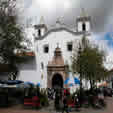|
| Important Towns
| Historical Routes | Archeological
Ruins |
| Indigenous Markets | Artisan
Goods | Ethnic Groups |
 |
Towns of Historical and Cultural
Importance
Surrounded by mountains, traversed by four rivers, and home to beautiful
14th- and 15th- century architecture, Cuenca surprised nobody when it
was declared a World Heritage Site by UNESCO. In the Old Town, you will
find Parque Calderón and other colonial parks and plazas, neighborhoods
that date back to the first days of the Spanish conquest of the area,
and religious art museums showcasing some of Ecuador’s most impressive
artwork. Also to be admired in this area are architecturally impressive
buildings and churches such as the Old and New Cathedrals, Santo Domingo,
San Sebastián, and San Blas, to name but a few. The city is also
famous for hosting the International Art Fair. The most impressive of
the city’s many museums are as follows: Banco Central, Casa de la
Cultura, Conceptas Convent, Remigio Crespo Toral, Artes Populares de América,
Arte Moderno, and Instituto Azuayo de Folclore. With so much cultural
heritage to offer the tourist, it’s no surprise that Cuenca was chosen
as the Cultural Capital of the Americas in 2002.
TOP
Historical Routes
There are several ways to reach the Ingapirca - or the Temple of the Sun
- located in Cañar. The Inca Trail is a walk that can take three
days. It begins in the town of Achupallas, 25 km from Alausí. To
undertake this journey it is important to bring the appropriate camping
equipment. The help of a guide or a specialized travel agency can be especially
useful, as well. Along the route, the hiker encounters great geographical
variation - Mapahuiña hill, Las Tres Cruces Lake, the Quilloloma
Hill, and the rock faces of Paredones de Culebrillas. The final destination
is the village of Ingapirca with its ancestral ruins.
TOP
Archaeological Ruins
Built with perfectly shaped stones and natural mortar, Ingapirca, 53 km
from Azogues, is the most important archaeological complex in Ecuador.
It is located in the province of Cañar. The elliptically shaped
“Templo del Sol”, or Temple of the Sun, was the center of the
ceremonies and rituals of the Cañari-Inca culture. It also had
a variety of strategic military purposes. The ruins are made up of a cemetery,
solar observatory, pathways, storerooms, priests’ quarters, and an
indigenous square.
Also located in the proximity of Cañar, Necrópolis watches
over ancient pieces of ceramics characterized by serpent figures. The
site is an old cemetery of the Cañari culture.
In Azuay, there are other vestiges of the same culture such as Todos Santos
and Pumapungo, the latter being a site which reveals a complex of religious
passageways leading to a special room for chosen women, storage areas,
a sun temple, a mausoleum, and Incan gardens. All are connected with an
exterior palace, the Residencia del Cacique. Thirty sculptures have been
recovered from the site as well as offering wells. There is a also a museum
located where various canals merge with intermediate pools and internal
constructions that connect with Todos Santos.
Another site of archeological interest is the Chobshi Ruins’ Cave.
It houses inscriptions and paintings in the designs of quadrangular constructions
of various sizes surrounding one another and protected by a stone wall.
TOP
Indigenous Markets
Cuenca offers urban handicrafts in a rural setting – finely moulded,
and rustically hand-decorated ceramics; outfits embroidered with multicolored
threads; baskets of reed and bulrush; metal panel works; textiles; forged
ironworks; straw hats; and fine filigree works of gold. These artisans
exhibit their wares on las Herrerías street, in Rotary and Otorongo
Squares, and in the neighborhood of la Convención del Cuarenta
y Cinco. In Santiago de Gualaceo, there are Sunday fairs that offer diverse
handicrafts (gold-work, basket-weaving, shoe-making, straw articles, ceramics,
and embroidery).
TOP
Artisan Goods and Handicrafts
Cañar’s capital city of Azogues, is well known for its production
of paja toquilla (a variety of straw) hats, ceramics, and textiles. In
Déleg, 25 km away, you can find colored handicrafts such as shigras
(fiber bags), sashes, and ponchos of all shapes, sizes, and colors. Jatumpamba,
in San Miguel de Porotos, is another place in the region where craftsman
produce red ceramic utensils. The town of Chordeleg, on the other hand,
is more known for its production of fine filigree as well as for its high-quality
necklaces, pendants, rings, bracelets, and a variety of other accessories
handcrafted from gold and silver. The town is also a small hub for ceramic
production and sales, as well.
Another canton of Cuenca is San Bartolomé, where the locals manufacture
guitars, mandolins, etc. San Fernando, also in the province of Azuay,
stands out for its production of ponchos and blankets. In San Juan Bautista
de Pucará, in the Nabón and Oña sectors, skilled
artisans work with wheat stalks. In Loja, the tailoring of the indigenous
skirts and pressed hats is an attraction. There are also woodcrafts, ceramic,
reed baskets, and musical instruments made of wood.
TOP
Ethnic Groups
In the southern region, you’ll notice the presence of another part
of the native Quichua population. It is divided between the Cañaris
- an indomitable, valiant race who inhabit the Cañar Province -
and the Saraguros, who conserve their identity in their lineage and customs.
The Saraguros, one of the most important indigenous groups in America,
have achieved great economic success due to their impressive work ethic.
TOP
| Important Towns
| Historical Routes | Archeological
Ruins |
| Indigenous Markets | Artisan
Goods | Ethnic Groups |
|

